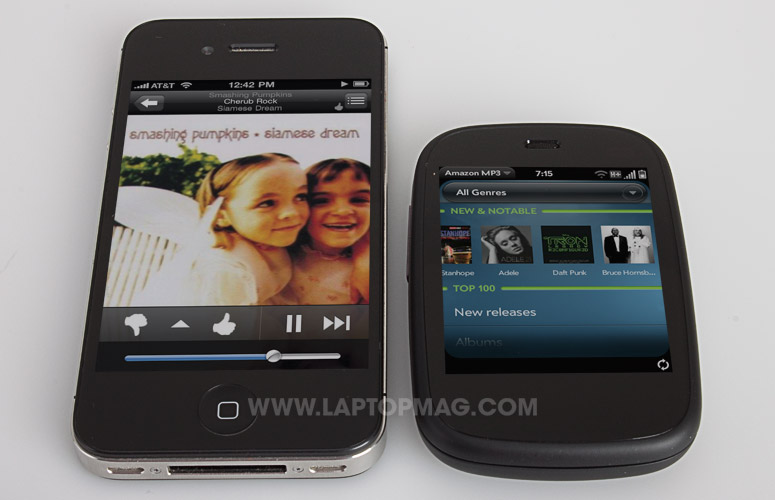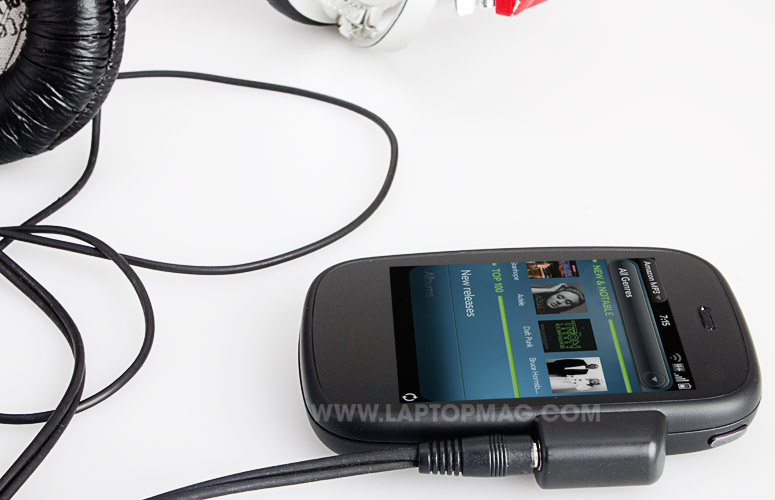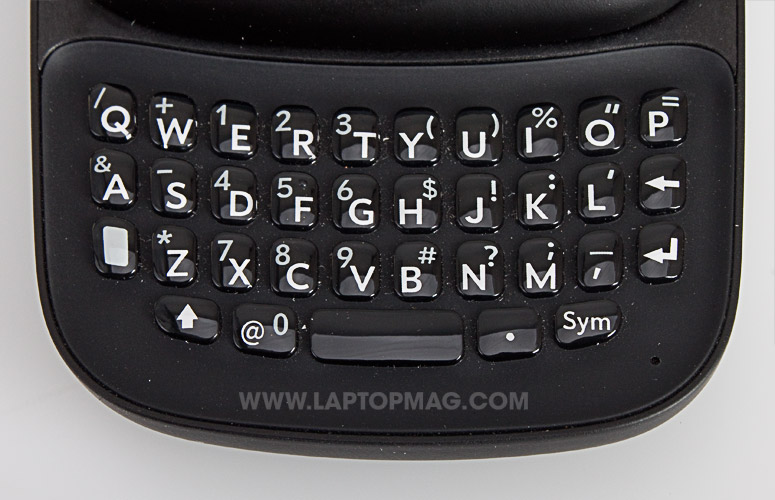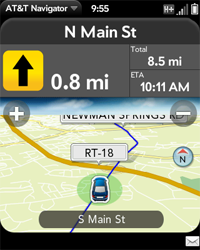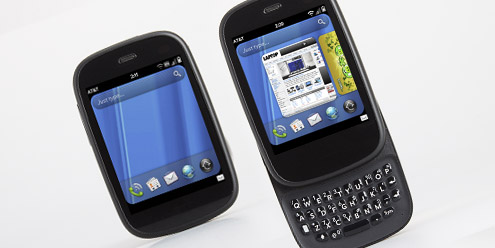Laptop Mag Verdict
The HP Veer 4G packs a lot of features into a very compact package, but it requires too many trade-offs.
Pros
- +
Very small and light
- +
Well-designed keyboard
- +
Time-saving Just Type feature
- +
Loud speaker
Cons
- -
Headphone jack requires accessory
- -
Screen too small
- -
Slow "4G" speeds
- -
Poor video camera
Why you can trust Laptop Mag
It's really tiny, but it's also kind of a big deal. That's because the Veer 4G is HP's first smartphone running webOS, which the company paid Palm $1.2 billion to get. While important, the underlying software isn't the real story here. It's the ridiculously small design. HP is pitching the Veer 4G ($99 for AT&T) as a sort of antidote to super-sized Android phones; a Mini Cooper in an SUV world. Seriously, this follow-up to the Palm Pixi is so compact you could almost wear it as a watch. So is this itty-bitty phone actually practical? Try our in-depth review on for size.
Design
You really have to hold the pebble-shaped Veer 4G in your hand to appreciate just how miniscule it is. Measuring 3.3 x 2.2 x 0.6 inches when closed, the smooth, rounded Veer 4G is shorter than a credit card and just a bit taller than a stick of gum. This device makes the iPhone 4 (4.5 x 2.3 x 0.4) look giant, never mind larger Android superphones. The Veer 4G is also very light, at 3.6 ounces, compared to 4.8 ounces for the iPhone and 4.9 for the Infuse 4G. Our unit was black with dark chrome buttons, but you can also order the Veer in white.
The Veer 4G is so small we actually felt silly holding it up to our head to make calls; we had to extend the slider to make it more natural. However, the soft-touch back provides a good grip. As with the Palm Pre line, the back of the top half of this slider has a mirrored finish.
Click to enlarge
The top of the Veer 4G houses a mute switch, and a power button is on the right corner toward the top where your thumb rests. Beneath that is a proprietary power connector that connects to the included power/USB cable magnetically. (Fans of industry-standard microUSB connections should look elsewhere.) The volume control is on the right side, and a 5-megapixel camera and speaker reside on the back.
Click to enlarge
Sign up to receive The Snapshot, a free special dispatch from Laptop Mag, in your inbox.
Click to enlarge
A capacitive strip that doubles as a home button and notification light is located under the wee 2.6-inch screen. This whole surface works as a gesture area (more on that below).
What's missing? A headphone jack. That's a pretty shocking omission for a 2011 smartphone, even though we know it was sacrificed for the Veer 4G's compact design. HP expects users to attach a small magnetic headphone adapter. This accessory didn't detach when we removed the device from our pocket, but it bloats the design and makes accessing the power button more difficult. Plus, we can pretty much guarantee that many Veer 4G owners will lose this small adapter. This add-on alone will be a deal-breaker for many.
Click to enlarge
Keyboard
One of the features we like most about the Veer 4G is its keyboard. Those with large hands will have a tough time with the layout, but we typed sentences fairly quickly with the raised, gummy keys. Other pluses include the bright backlight and dedicated @ key. The Veer 4G doesn't feature a touch keyboard, though the screen is so small we're not sure users would want one on this design.
Click to enlarge
Display and Audio
Measuring 2.6 inches, the Veer 4G has the smallest touchscreen we've seen on a phone since the Kin One. While the panel is bright, colorful, and generally responsive, 400 x 320 pixels is a pretty low resolution these days. The BlackBerry Bold 9650 offered 460 x 360 pixels on a non-touch, 2.4-inch screen a year ago. Viewing content such as web pages on the Veer 4G in portrait mode proved to be a challenge; we had to pinch-to-zoom or flip the phone around to make out text on NYTimes.com. We also had to squint to play Angry Birds, and we have 20/20 vision.
Click to enlarge
Click to enlarge
The Veer 4G's speaker on the back pumped out enough volume to hear our Pandora stream in the kitchen with the faucet running in the background. Spoken directions were also loud and clear when using the bundled TeleNav GPS app.
webOS and Interface
Click to enlargewebOS, now in version 2.1.2, continues to shine in some areas, especially multitasking. To minimize an app, just swipe up from the gesture area. You can then whisk the app off the screen to close it, or move left or right to switch to other open apps. Going back involves swiping from right to left in the gesture area. If you want to open an often-used app without returning to the home screen, swipe up from the gesture area without lifting your finger, then select an icon such as Phone or E-mail. HP includes a Gesture Tutorial to get first-time webOS users started.
We continue to appreciate the way webOS handles notifications. They appear in the bottom right corner of the screen, and when you tap it you'll see the subject of the e-mail message, for example. On the Veer 4G the notifications are almost too tiny to tap, but they're still welcome. If an application is tightly integrated with webOS, such as Pandora, you can control music playback from the notification bar.
A very welcome new feature is Just Type. Tap the Just Type area with the keyboard open, then start typing away. The Veer 4G will let you perform searches of all types from this menu (apps, contacts, e-mail, web, etc.) and also start an e-mail, Facebook update, or text message. You'll need to scroll down and then tap one of the Quick Action options, though we had to tap More to see Facebook as an option. We wish we could customize the order of Quick Actions.
Click to enlarge
As with previous webOS phones, the Veer 4G does a nice job of combining contacts and calendars in a unified view. It syncs with Exchange, Facebook, Google, LinkedIn, and Yahoo. Still, webOS has some holes compared to Android. For example, you can share pictures from the photos app via Facebook but not Twitter, and you can't share online articles with either service directly from the browser.
Specs and Performance
The Veer 4G packs an 800-MHz Qualcomm MSM7230 processor, the same CPU found in the T-Mobile G2 launched last October. Although you can buy a $99 smartphone with a more powerful 1-GHz processor, the Veer 4G was pretty snappy when opening apps and switching between them. However, we noticed lag with the accelerometer switching screen orientation, when rendering pictures in the photos app, and loading applications that rely on data from the web (such as Facebook). The App Catalog took a lengthy 34 seconds to load while we were streaming Pandora over 3G.
You get 8GB of internal storage with the Veer 4G. That's a decent amount of space, but you can't upgrade it. Also, you can't use the phone at all while you're using it as a USB drive.
Apps
Click to enlargeThe App Catalog has HP branding now, but it's still way behind Android and iOS. There are only about 6,000 apps. Well-known apps include Angry Birds (multiple versions), Evernote, Facebook, Fandango, Foursquare, and Yelp. Just as notable as what's here is what's not. There's still no official Twitter client for webOS, though there are some pretty good third-party options, and the overall game selection is pretty skimpy.
Notable bundled apps include AT&T Navigator ($9.99 per month), which provided accurate spoken directions and was quick to lock onto our location. We also like Amazon MP3 for downloading tunes, even though it doesn't work with Amazon's cloud streaming service like the Android app does. QuickOffice lets you view office documents; just be prepared to zoom in on the Veer 4G's small screen.
Click to enlarge
Web Browsing and Data Performance
Like most AT&T 4G phones, the Veer 4G doesn't really offer 4G speeds. Using the Net Speed app, the phone delivered download rates ranging from 743 Kbps to 1.1 Mbps in New York City, and uploads that barely cracked 100 Kbps. With good signal strength, mobile sites such as ESPN.com and NYTimes.com loaded in 8 to 9 seconds. That's decent, but 4G phones from other carriers take half as long. Flash sites also proved a challenge for the Veer 4G. PBS Kids took so long to load over "4G" that we just gave up.
Those who want to share the Veer 4G's data connection can use the included mobile hotspot app, but given the phone's slow speeds, we don't think it's worth the extra $25 per month for 2 extra GB.
Camera and Camcorder
As an imaging device, the Veer 4G delivered mixed results. The still shots we took outdoors with the 5-MP camera impressed with vivid colors and pretty sharp detail. The phone also snapped shots quickly. You can upload photos to Facebook from the Photos app, but you'll need to use the dedicated Facebook app if you want to add a caption first. Despite the lack of a flash, photos taken indoors didn't suffer from too much grain.
Click to enlarge
Footage we shot with the Veer 4G's old-school VGA camcorder looked pretty poor when played back on our laptop. We noticed a lot of pixelation and blurring.
Call Quality and Battery Life
The calls we made with the Veer 4G in New York and New Jersey sounded pretty clear to other callers. We noticed some fuzziness on our end of the line between words, but otherwise the quality was good.
Despite having a small 910 mAh battery, the Veer 4G lasted a long time between charges. After unplugging the phone at around 6 a.m., the device showed 22 percent battery left by 4 p.m., so you should be able to make it through most of, if not all of, the day before having to find an outlet.
Verdict
The HP Veer 4G doesn't really offer anything that would tempt an iPhone or Android phone owner to buy this device. It's more like a messaging phone that can do a lot more. But even viewed in that light, the Veer 4G doesn't hit the mark. While the design is remarkably small and pocket-friendly, the screen is tough to read in portrait mode, and you have to attach an awkward accessory just to plug in headphones. We think the phone would have worked better as a landscape slider. The video camera is also unimpressive for a $99 smartphone when you can get 720p video recording--and better games--from the $49 Samsung Focus. The bottom line is that the Veer 4G is more fun to show off than it is to use.
Click to enlarge
HP Veer 4G Specs
| Bluetooth Type | Bluetooth 2.1 EDR with A2DP |
| Brand | HP |
| CPU | 800 MHz Qualcomm MSM7230 |
| Camera Resolution | 5 MP |
| Carrier | AT&T |
| Company Website | http://www.hp.com |
| Data | GPRS/EDGE/HSDPA/UMTS |
| Display (main) | 2.6 inches/400 x 320 |
| Form Factor | QWERTY Slider |
| GPS | Yes |
| Internal Memory | 8GB |
| Memory Expansion Type | none |
| Networks | Tri-band UMTS: 850/1900/2100 HSDPA Cat 10/HSUPA Cat 6; Quad-band GSM/EDGE: 850/900/1800/1900,GSM/GPRS/EDGE |
| Operating System | webOS 2.1.2 |
| Ports | magnetic connector |
| Size | 3.3 x 2.2 x 0.6 inches |
| Weight | 3.6 ounces |
| Wi-Fi | 802.11b/g/n |

